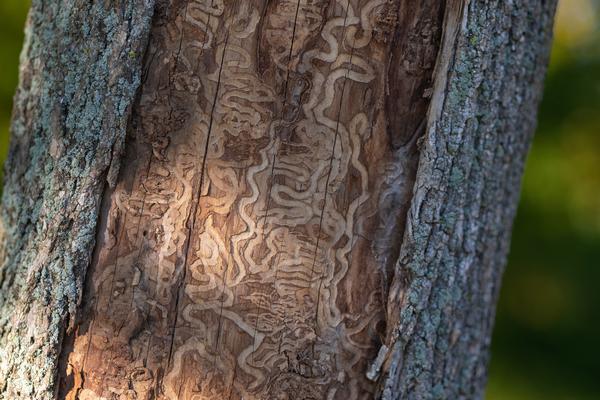Emerald ash borer, or EAB as it is commonly referred to, is an emerald green beetle that feeds on ash species of trees. What do you need to about EAB? Will this pesky little beetle harm your trees? Here’s everything you should know about EAB straight from the Denver tree service experts at Splintered Forest.
Do You Have an Ash Tree?
It is important to be certain you have identified your tree as an ash tree before you decide to treat it for emerald ash borer signs. In rare cases, EAB can affect other trees, but if the affected tree is not an ash tree, it isn’t likely that EAB is the issue.
Ash trees have large canopies with multiple stems and offer plenty of shade. Amongst the ash tree species, there are a few things you will find to be consistent including:
- They all have opposing buds on the stem that are easy to see
- The leaves are compound leaves, meaning they are composed of leaflets. Ash trees have 5-7 leaves per leaflet.
- The bark tends to be smooth on younger ash trees and begins to roughen up as they age. The bark of the green ash tree takes on a diamond shape.
- Green ash, black ash, and blue ash trees have a yellow color in fall, while white ash has a purple fall color.
EAB prefer all types of ash trees except for the mountain ash, because these are actually not ash trees; rather they are part of the rose family.
What is an Emerald Ash Borer?
The Emerald Ash Borer originated in Asia and was first discovered in the United States in 2002 in Detroit. This tiny beetle is smaller than a dime, usually about ½ to ¼ inch long and about ⅛ inch wide, with a bright metallic green color. They typically make themselves known in mid to late May. Larvae bore into the ash tree and feed underneath the bark.
Emerald Ash Borer Signs of Damage
One of the most challenging parts about an EAB infestation is that there may not be any emerald ash borer signs on the outside of the tree until damage has already been done. EAB larvae feed off of the inner bark of the tree, so the damage is happening under the bark. This larvae feeding frenzy prevents the tree from being able to transport water and nutrients to other areas. Over time, the area above the infested part of the tree will begin to thin out and die. The adult beetles nibble away at the bark of your ash trees, which can also go undetected for a period of time. It is estimated that one-third to one-half of a tree infested with EAB will be dead within one year, so it’s important that homeowners act quickly by contacting a professional as soon as possible.
Identifying an EAB Infestation
There are a number of symptoms of EAB that homeowners should be aware of in order to protect their trees.
Look at the Bark
First, look for vertical splitting in the bark. This occurs when the EAB larvae begin to destroy the interior of the tree, and often, you may be able to see the larvae beneath the split.
Woodpeckers
If you frequently see woodpeckers in and around your ash trees, you may want to investigate further. Woodpeckers feed on EAB larvae, and when there are a lot of larvae for the woodpeckers to eat, the birds can strip pieces of bark off of the tree to get to them. This will usually occur on the higher portions of the tree, so don’t forget to look up when checking for signs of damage.
Inspect the Crown of Your Tree
You may also notice the crown of your tree dying, which occurs after larvae have been feeding on the inner tree for long periods of time. Or, your tree could also be sprouting new growths at the base of the tree, according to our professionals.
Look for Emerald Ash Borer Signs
Homeowners may see the bugs themselves, but if not, look for tiny, D-shaped emergence holes, which is how adult EABs exit the bark. The outer bark will usually hide signs of larvae, but if you strip back the outer layer of bark and see an s-shaped pattern beneath it, this is a sign the larvae are feeding inside your tree.
How Can You Prevent EAB?
Consult with your local tree experts to determine whether your tree is healthy enough for EAB pesticides and prevention. Some of the most effective treatments are injected into the tree each year for continuous protection. Treatments are only recommended if you currently live within 15 miles of a known EAB infestation, so not every homeowner will need it. Schedule a free estimate for Plant Health Care Services from Splintered Forest. We can spray to prevent further tree damage in the following seasons.
Contact Splintered Forest
Splintered Forest is a leading fire mitigation and tree services business serving the mountain communities/Denver Metro Area and is committed to delivering the best service in the industry. The crew includes ISA Certified Arborists, experienced tree climbers, and expert tree fellers. If you think you may be seeing emerald ash borer signs of damage, contact us today to schedule your free, no obligation estimate.
Read more about ash tree identification. Regular inspections and EAB Treatments are necessary to protect your Ash tree from the devastating effects of EAB.

